Tips and Techniques
Camp | Michigan Deer Hunting | Tips and Techniques
| Packing Lists | Recipes
Michigan Deer Hunting History | Deer Camp Photos | Photo Submission | Links | |
 |
| Complete Wall Tent Information Guide Click Here |
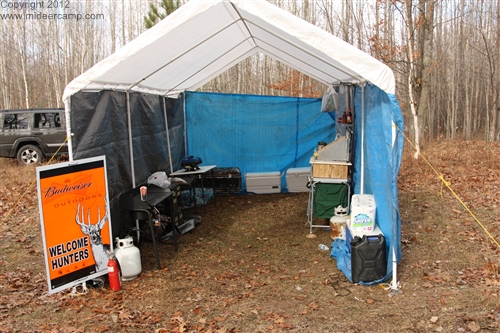 |
Cook/Mess Tent
This is our cook tent. It is a carport tent and we added tarps to the side to stop the wind. The tent is staked down to keep it from flipping over. We cook in a different tent, because we do not want all the cooking smells on our cloths and lack of room in the wall tent.
The cook tent contains a Camp Chef two burner stove, a Chuck Box, folding table, 4 coolers, a Cabelas Deluxe Kitchen, a small stove, and water containers. |
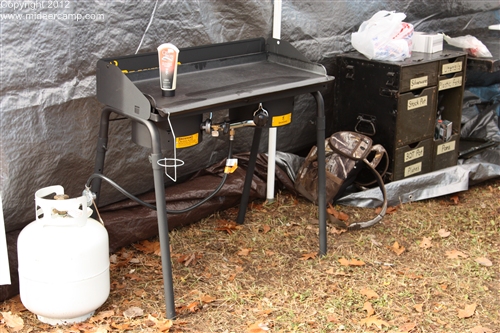 |
Cooking Stove
This is our Browning two burner stove made by Camp Chef. We added a griddle to cover both burners. With a griddle this size, we are able to cook breakfast for everyone at one time. It also boils water and heats up food much faster then a tradational camp stove.
Next to the stove is the Chuckbox. The Chuckbox is opened so kitchen items can be taken out, and the top used as a countertop. |
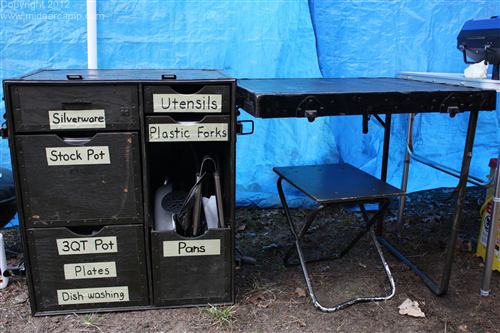 |
Kitchen Organization
A kitchen Chuck Box is used to store and organize your kitchen utensils.
Click Here for more Photos of the Chuckbox. |
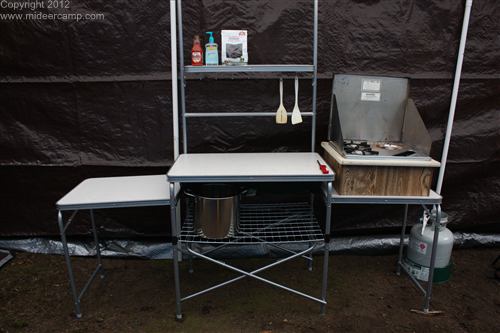 |
Here is the Cabelas Deluxe Kitchen. It has a lot of counter space and shelf space. It is nice because it has 2 hooks to hang lanterns off of. There are hooks for hanging utensils off. There is also shelf to store spices and sauces.
On the right of the Kitchen is our 3 burner stove, which came out of an old pop up trailer. |
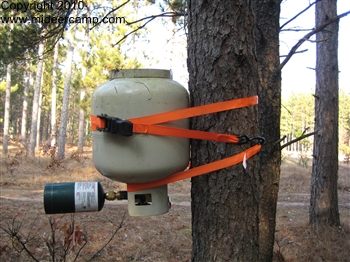 |
Propane Refill
A one pound propane refill station is used to refill one pound cylinders from a bulk 20 pound cylinder.
Click Here for more Photos of the Propane Refill Station. |
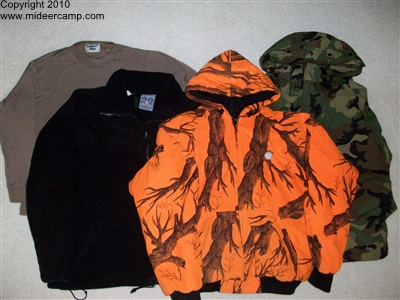 |
Dressing for Cold Weather
Do you need some expert advise on how to dress for the cold weather while deer hunting? Here are the experts in cold weather clothing.
Click Here for information on Cold Weather Clothing including:
United States Antarctic Program cold weather field manual.
Northern Outfitters
US Army Extended Cold Weather Clothing System. |
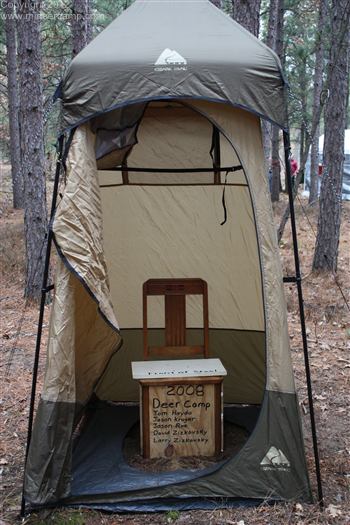 |
Outhouse
Here is the outhouse. It is a vital part of deer camp.
The tent is an inexpensive shower tent bought at wally world. A section of the bottom was cut out to go over the hole. The tent has compartments for TP or baby wipes.
A few days worth of use and it will get "Ripe". We purchased some RV toilet chemicals, and when it gets ripe just add a couple of drops down the hole. Works like a charm.
The fully wooden chair was found on the side of the road going to be thrown out. We cut a hole in it and sanded it so you don't get a sliver. We then kept the wood circle that was cut out for the hole, and made it a plug (to keep the stink down). Boards were added to the sides of the chair giving it "Splatter Guard Technology". |
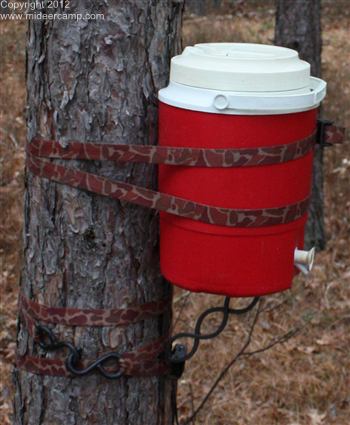 |
Field Sanitation
This is the hand wash station. It is an old water jug with a spigot on the bottom. The water jug is supported with a triangle shaped metal brace. The metal brace was purchased at a hardware store and is a shelf support.
To create the hand wash station, we have one person hold the support and the water jug. A 2nd person takes a ratchet strap and lashes the support and water jug to a tree. We then put a bottle of liquid soap on the top of the water jug. |
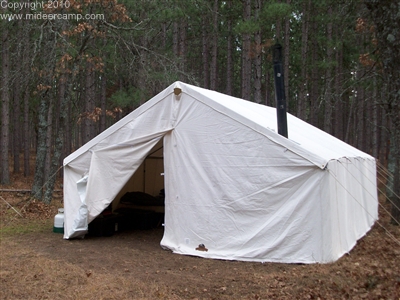 |
Wall Tent
Here is our 16'x 20' Bighorn Wall Tent. It is manufactured by Reliable Tent and Tipi out of Billings, Montana. We can fit up to 8 guys with wood burner, firewood, cots and gear in the tent. |
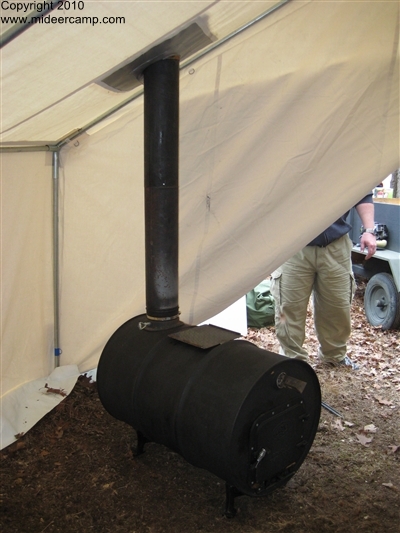 |
Primary Heat Source
The woodburner was built from 55 gallon drum and a woodburner kit was added. We add a few inches of dirt to the bottom. Before going to bed, we get the fire hot, fill it up with wood, and then use damper to cut down on the air allowed to go up the chimney. This keeps the fire going to about 2 AM and then someone will usually get up and add some more wood. We stack the firewood near the woodburner to dry it out.
A steal plate was added to the top so a small pot of water could be placed on top. The water evaporates and keeps the tent from getting too dry.
|
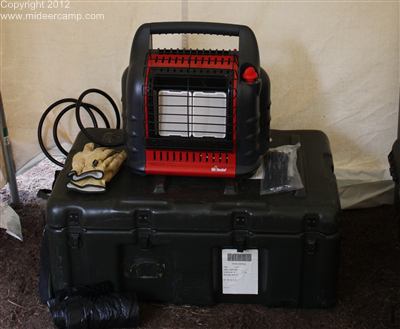 |
Alternate Heat Source
Our alternate heat source is a Mr Heater. It works great in the morning. Most of the time we do not want to add firewood to the woodburner in the morning, because we are leaving to go hunting. We still need some heat to get ready, so we fire up the Mr. Heater.
The Mr. Heater is designed to work using 1lb disposable propane bottles. The 1lb propane go too quick, so we attach the Mr. Heater to a 20lb propane bottle. |
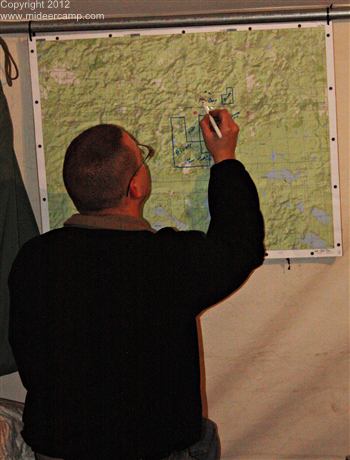 |
Map Scouting/Reconnaissance
In the wall tent we keep a large map on the wall. We plot on the map private property, other deer camps, other hunters locations, and where we are going to hunt.
We keep our GPS in UTM (Universal Transverse Mercator) for grid coordinate units. This way we are able to take the grid coordinates we saved in the field and be able to plot the point on the map. |
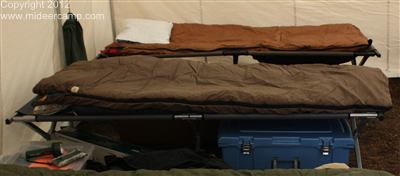 |
Cots
No matter how big your wall tent is your space is going to be limited. In order to maximize space you need to make sure purchase the right cot. The space under the cot needs to be used and is the perfect place to stow you cloths. Purchase a cot where there is plenty of room to put a footlocker under it. Measure your footlocker and make sure there are a few more inches, so when you lay on the cot you are not touching the footlocker. Larry’s cot shown in the picture is 19.5 ” in height, 80” long, 30” wide, and was purchased at Gander Mountain. |
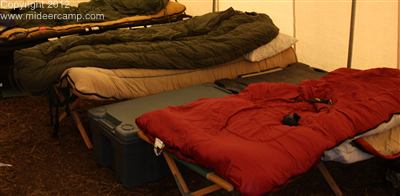 |
If you buy a cot with not a lot of height then gear will be stowed next to the cot and wasting more space. These cots are too small and waste space with footlockers that will not fit underneath. |
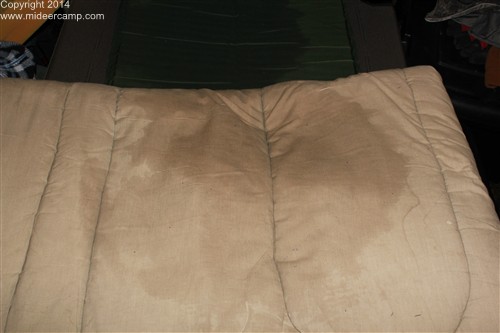 |
CondensationWhen rolling up the sleeping bags, Dave and Steve found a lot of condensation. Dave and Steve both used a thick sleeping bag for a base layer. They slept in a separate sleeping bag as a base bag. Their sleeping bag was dry and the top of the base sleeping bag was dry. However, the bottom of the base bag was soaked, Dave’s Air Pad was soaked, and Steve’s cot was soaked. |
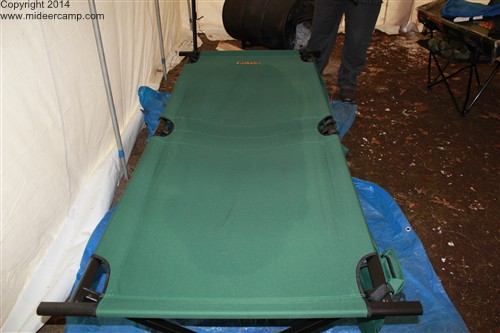 |
The cold of the air is condensing with it is meeting the warmth created by the body. In Dave’s case, the condensation was between the air pad and the base sleeping bag. In Steve’s case, the condensation was at the cot and the base sleeping bag. This is the first year anyone has had this issue. No one else in camp had an issue with condensation. Kruger had a wool blanket as a base, but had a tarp that his cot was located on. The ground under Kruger was wet when he lifted up the tarp. Did his tarp keep him from having a condensation issue? I guess we do not know. So for whatever reason condensation was an issue. We learned that everyday, you need to move all the layers of your sleep system and allow them to dry. Otherwise you might be trying sleeping on a block of ice and not even know it. |
| Back to Deer Camp |

































